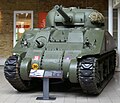| Revision as of 20:27, 21 September 2008 editThe Anomebot2 (talk | contribs)Bots, Extended confirmed users1,043,658 edits Replacing geodata: {{coord|51|29|45|N|0|06|30|W|region:GB_type:landmark|display=title}}← Previous edit | Revision as of 11:26, 13 October 2008 edit undo217.41.240.15 (talk) Update for new DGNext edit → | ||
| Line 17: | Line 17: | ||
| In addition to material artifact holdings, the Imperial War Museum archives houses a large collection of oral recordings of interviews with people who were affected by war in the 20th century. The sound archive has been used for a series of ] programmes and books, called ], about war in the 20th century, including ] and ]. | In addition to material artifact holdings, the Imperial War Museum archives houses a large collection of oral recordings of interviews with people who were affected by war in the 20th century. The sound archive has been used for a series of ] programmes and books, called ], about war in the 20th century, including ] and ]. | ||
| Since |
Since October 2008, the museum's Director General has been ]. The previous Director General, from 1995 to 2008, was Sir ], ]. | ||
| ==History== | ==History== | ||
Revision as of 11:26, 13 October 2008
| This article relies excessively on references to primary sources. Please improve this article by adding secondary or tertiary sources. Find sources: "Imperial War Museum" – news · newspapers · books · scholar · JSTOR (July 2008) (Learn how and when to remove this message) |
 | |
| Established | 1917 |
|---|---|
| Location | Lambeth Road, London SE1, England |
| Visitors | 712,000 (2006) |
| Director | Sir Robert Crawford, CBE |
| Website | www.iwm.org.uk |
| Imperial War Museums | |
The Imperial War Museum is a museum in London, England featuring military vehicles, weapons, war memorabilia, an extensive library open to the public Monday to Saturday, a photographic archive, and an art collection of 20th century and later conflicts, especially those involving Britain, and the British Empire. The museum serves as headquarters of a 5-branch system of related facilities. Funding comes partially from government grants as well as individual contributions and revenue generation through retailing, licensing income and other commercial activity. The museum is a Non-Departmental Public Body.
In addition to material artifact holdings, the Imperial War Museum archives houses a large collection of oral recordings of interviews with people who were affected by war in the 20th century. The sound archive has been used for a series of radio programmes and books, called Forgotten Voices, about war in the 20th century, including Forgotten Voices of the Great War and Forgotten Voices of the Holocaust.
Since October 2008, the museum's Director General has been Diane Lees. The previous Director General, from 1995 to 2008, was Sir Robert Crawford, CBE.
History
Originally located inside the Imperial Institute (now Imperial College), the Imperial War Museum was moved temporarily to the Crystal Palace, located atop Sydenham Hill. The Museum was founded there in 1917 to commemorate those who had died in the First World War, even though the war had not yet been concluded. When that building burned down on 30 November 1936, a new location was found in Lambeth Road, Southwark. That building, designed by Sydney Smirke, had originally been a psychiatric hospital, Bethlem Royal Hospital (otherwise known as "Bedlam"), located in St. George's Fields. In 1939, the Museum began including displays relating to the Second World War, and then finally in 1953 it began its current policy of including memorabilia from all modern British conflicts.
Visiting the museum
Entrance is free, though there may be charges for special exhibits. Donations are encouraged. It is open daily, 10.00 am – 6.00 pm.
Other branches
The Museum serves as headquarters of a five-branch series of inter-related museums located throughout the United Kingdom. The other branches include:
- Located in the bunker which was operational nerve centre of the British government during World War 2.
- An aerospace museum, including many military aircraft.
- Opened in 2002 to provide access to the people of the North to the museum's collections.
Selected exhibition items
At the entrance to the museum two 15 inch (381 mm) guns can be seen: one from HMS Ramillies the other from HMS Resolution and HMS Roberts.
-
 Fragment of the Berlin Wall
Fragment of the Berlin Wall
-
 A replica of the Colditz "Cock" Glider
A replica of the Colditz "Cock" Glider
-
 P-51 Mustang
P-51 Mustang
-
 Sherman III tank
Sherman III tank
-
 Heinkel He 162A-1
Heinkel He 162A-1
-
 Jagdpanther tank destroyer, frontal view
Jagdpanther tank destroyer, frontal view
-
An exhibit on espionage
-
A Korean war exhibit
- A Focke-Wulf Fw 190 A Focke-Wulf Fw 190
-
 A V-2 rocket
A V-2 rocket
-
 A Supermarine Spitfire Mark IA
A Supermarine Spitfire Mark IA
-
 "Ole Bill", a LGOC B-type bus
"Ole Bill", a LGOC B-type bus
See also
- Forgotten Voices of the Great War
- Forgotten Voices of the Holocaust
- Forgotten Voices of the Second World War
- Forgotten Voices of the Blitz and the Battle of Britain
- Forgotten Voices of the Falklands
External links
- Official website of the Imperial War Museum
- Location map from streetmap.co.uk
- Historical picture of Bethlem Royal Hospital (current location of the IWM)
- 1999 - Mario Petrucci becomes the Museum's first poet in residence
- Information on the 15" guns outside the museum's main entrance
- The Forgotten Voices website
51°29′45″N 0°06′30″W / 51.49583°N 0.10833°W / 51.49583; -0.10833
Categories:- Museums established in 1917
- Military museums in England
- Archives in England
- Archives in London
- World War I museums
- Military museums in London
- Museums sponsored by the Department for Culture, Media and Sport
- Buildings and structures in Southwark
- Military and war museums
- Defunct hospitals in England
- Domes
- Non-Departmental Public Bodies of the United Kingdom government